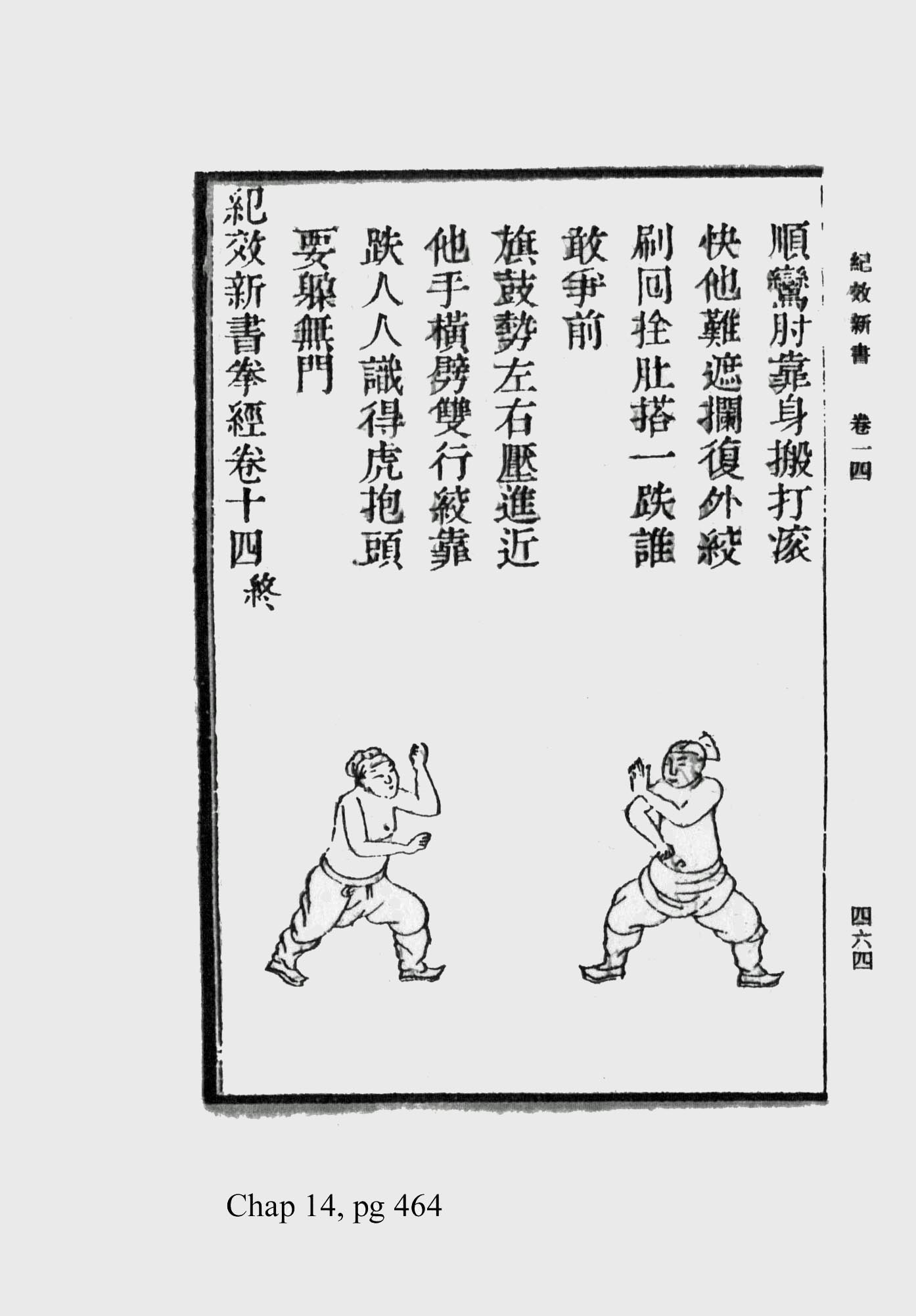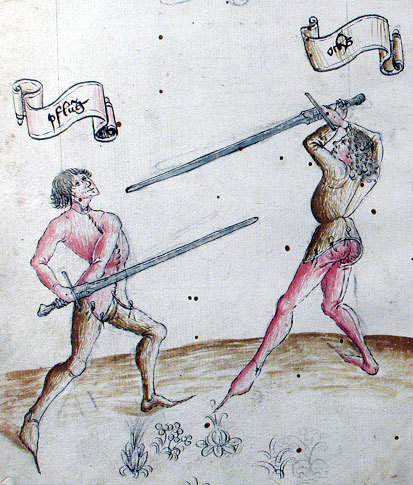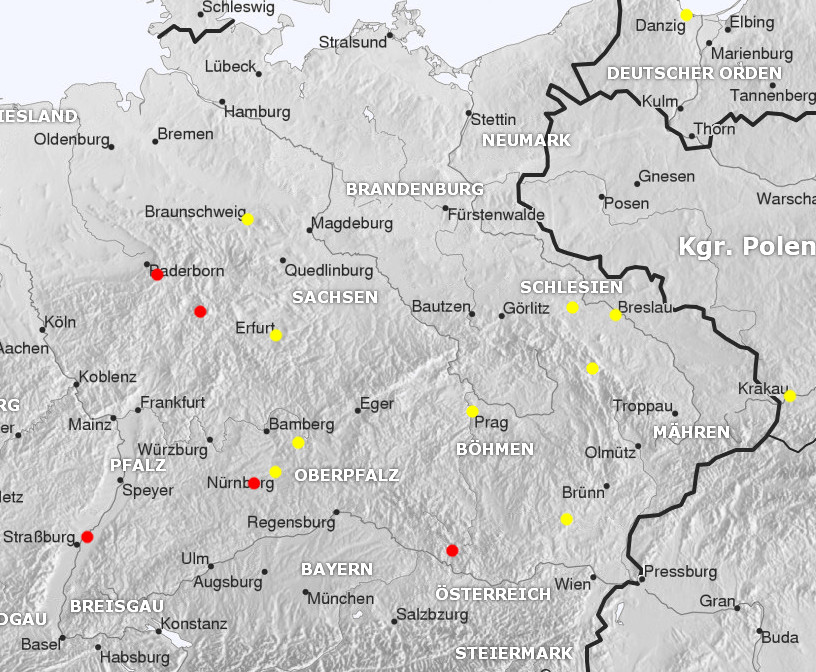|
Glasgow Fechtbuch
{{Short description, Combat manual The Glasgow Fechtbuch (MS E.1939.65.341 in the R. L. Scott Collection of the Glasgow Museums in Glasgow, Scotland) is a combat manual of the German school of fencing, dated to 1505. Consisting of 105 folia, it combines the instructions of various masters of the 15th century who stood in the tradition of Johannes Liechtenauer, presumably based on a previous compilation made by fencing master Sigmund Schining ein Ringeck. Contents: ;''Blossfechten'' (longsword and messer) *1r - 22r Gloss of Liechtenauer's longsword ''Blossfechten'' by Ringeck (fragment) *22v - 24r Additional longsword material by Ringeck *24v - 25r Longsword by Martin Syber *25v - 26v Messer (weapon), Messer treatise *27r - 29v Additional longsword material by Andres Juden, Jobs von der Nyssen, Nicolas Preussen, and Hans Döbringer (viz., the same "other masters" as referenced in MS 3227a) *35r (Image of a seated master, possibly Liechtenauer, reminiscent of the depiction in C ... [...More Info...] [...Related Items...] OR: [Wikipedia] [Google] [Baidu] |
Sigmund Ringeck
Sigmund Schining ein Ringeck (Sigmund ain Ringeck, Sigmund Amring, Sigmund Einring, Sigmund Schining) was a German Fencing master, fencing master. While the meaning of the surname "Schining" is uncertain, the suffix "ain Ringeck" may indicate that he came from the Rhineland region of south-western Germany. He is named in the text of his treatise as ''Schirmaister'' to one Duke Albrecht, Count Palatine of Rhine and Duke of Bavaria. Other than this, the only thing that can be determined about his life is that his renown as a master was sufficient for Paulus Kal to include him on his memorial to the deceased masters of the Johannes Liechtenauer, Society of Liechtenauer in 1470. Ringeck seems to have authored one of the few complete gloss (annotation), glosses of the epitome of the grand master Johannes Liechtenauer, making him one of the most important German fencing masters of the 15th century. The identity of Ringeck's patron remains unclear, as four men named Albrecht held the title ... [...More Info...] [...Related Items...] OR: [Wikipedia] [Google] [Baidu] |
Combat Manual
Martial arts manuals are instructions, with or without illustrations, specifically designed to be learnt from a book. Many books detailing specific techniques of martial arts are often erroneously called manuals but were written as treatises. Prose descriptions of martial arts techniques appear late within the history of literature, due to the inherent difficulties of describing a technique rather than just demonstrating it. The earliest extant manuscript on armed combat (as opposed to unarmed wrestling) is Royal Armouries Ms. I.33 ("I.33"), written in Franconia around 1300. Not within the scope of this article are books on military strategy such as Sun Tzu's ''The Art of War'' (before 100 BC) or Publius Flavius Vegetius Renatus' ''De Re Militari'' (4th century), or military technology, such as ''De rebus bellicis'' (4th to 5th century). Predecessors Some early testimonies of history of martial arts, historical martial arts consist of series of images only. The earliest example ... [...More Info...] [...Related Items...] OR: [Wikipedia] [Google] [Baidu] |
German School Of Fencing
The German school of fencing (') is a system of combat taught in the Holy Roman Empire during the Late Medieval, German Renaissance, and Early Modern periods. It is described in the contemporary Fechtbücher ("fencing books") written at the time. The geographical center of this tradition was in what is now Southern Germany including Augsburg, Frankfurt, and Nuremberg. During the period in which it was taught, it was known as the ', or the ''"Art of Fighting"''. The German school of fencing focuses primarily on the use of the two-handed longsword; it also describes the use of many other weapons, including polearms, medieval daggers, messers (with or without a buckler), and the staff, as well as describing mounted combat and unarmed grappling (''ringen''). Most authors of writings on the system are, or claim to be, in the tradition of the 14th-century master Johannes Liechtenauer. The earliest surviving treatise on Liechtenauer's system is a manuscript dated to 1389, known a ... [...More Info...] [...Related Items...] OR: [Wikipedia] [Google] [Baidu] |
Folia
''La Folía'' (Spanish), or ''Follies'' (English), also known as ''folies d'Espagne'' (French), ''La Follia'' (Italian), and ''Folia'' (Portuguese), is one of the oldest remembered European musical themes, or primary material, generally melodic, of a composition, on record. The theme exists in two versions, referred to as early and late ''folias'', the earlier being faster. History Due to its musical form, style and etymology of the name, it has been suggested that the melody arose as a dance in the mid or late fifteenth century throughout the Iberian Peninsula, either in Portugal or in the area of the old Kingdom of León, or maybe in the Kingdom of Valencia. The epithet "Folia" has several meanings in music. Western classical music features both "early Folia", which can take different shapes, and the better-known "later Folia" (also known as "Follia" with double l in Italy, "Folies d'Espagne" in France, and "'s Ground" in England). Recent research suggests that the origi ... [...More Info...] [...Related Items...] OR: [Wikipedia] [Google] [Baidu] |
Johannes Liechtenauer
Johannes Liechtenauer (also ''Lichtnauer'', ''Hans Lichtenawer'') was a German fencing master who had a great level of influence on the German fencing tradition in the 14th century. Biography Liechtenauer seems to have been active during the mid-to-late 14th century. The only extant biographical note on Liechtenauer is found in GNM Hs. 3227a (dated c. 1400), which states that "Master Liechtenauer learnt and mastered he art of the swordin a thorough and rightful way, but he did not invent it or make it up himself, as it is stated before. Instead, he travelled across and visited many lands for the sake of this rightful and true art, as he wanted to study and know it." His surname indicates he was from a place called ''Liechtenau'' (modern ''Lichtenau''). There are several places with this name. Massmann (1844) mentions five candidate locations: Lichtenau im Mühlkreis in Upper Austria; Lichtenau in Franconia, Nuremberg; Lichtenau on the Rhine, Baden, near Strasbourg; Licht ... [...More Info...] [...Related Items...] OR: [Wikipedia] [Google] [Baidu] |
Sigmund Schining Ein Ringeck
Sigmund Schining ein Ringeck (Sigmund ain Ringeck, Sigmund Amring, Sigmund Einring, Sigmund Schining) was a German fencing master. While the meaning of the surname "Schining" is uncertain, the suffix "ain Ringeck" may indicate that he came from the Rhineland region of south-western Germany. He is named in the text of his treatise as ''Schirmaister'' to one Duke Albrecht, Count Palatine of Rhine and Duke of Bavaria. Other than this, the only thing that can be determined about his life is that his renown as a master was sufficient for Paulus Kal to include him on his memorial to the deceased masters of the Society of Liechtenauer in 1470. Ringeck seems to have authored one of the few complete glosses of the epitome of the grand master Johannes Liechtenauer, making him one of the most important German fencing masters of the 15th century. The identity of Ringeck's patron remains unclear, as four men named Albrecht held the title during the fifteenth century. If it is Albrecht I, who r ... [...More Info...] [...Related Items...] OR: [Wikipedia] [Google] [Baidu] |
Longsword
A longsword (also spelled as long sword or long-sword) is a type of European sword characterized as having a cruciform hilt with a grip for primarily two-handed use (around ), a straight double-edged blade of around , and weighing approximately . The "longsword" type exists in a morphological continuum with the medieval knightly sword and the Renaissance-era Zweihänder. It was prevalent during the late medieval and Renaissance periods (approximately 1350 to 1550), with early and late use reaching into the 12th and 17th centuries. Names English The longsword has many names in the English language, which, aside from variant spellings, include terms such as "bastard sword" and "hand-and-a-half sword." Of these, "bastard sword" is the oldest, its use being contemporaneous with the weapon's heyday. The French ' and the English "bastard sword" originate in the 15th or 16th century, originally in the general sense of "irregular sword, sword of uncertain origin", but by the mid ... [...More Info...] [...Related Items...] OR: [Wikipedia] [Google] [Baidu] |
Martin Syber
Martin may refer to: Places * Martin City (other) * Martin County (other) * Martin Township (other) Antarctica * Martin Peninsula, Marie Byrd Land * Port Martin, Adelie Land * Point Martin, South Orkney Islands Australia * Martin, Western Australia * Martin Place, Sydney Caribbean * Martin, Saint-Jean-du-Sud, Haiti, a village in the Sud Department of Haiti Europe * Martin, Croatia, a village in Slavonia, Croatia * Martin, Slovakia, a city * Martín del Río, Aragón, Spain * Martin (Val Poschiavo), Switzerland England * Martin, Hampshire * Martin, Kent * Martin, East Lindsey, Lincolnshire, hamlet and former parish in East Lindsey district * Martin, North Kesteven, village and parish in Lincolnshire in North Kesteven district * Martin Hussingtree, Worcestershire * Martin Mere, a lake in Lancashire ** WWT Martin Mere, a wetland nature reserve that includes the lake and surrounding areas * Martin Mill, Kent North America Canada * Rural Municipality of M ... [...More Info...] [...Related Items...] OR: [Wikipedia] [Google] [Baidu] |
Messer (weapon)
A messer (German for "knife") is a single-edged sword with a knife-like hilt. While the various names are often used synonymously, messers are divided into two types: ''Lange Messer'' ("long knives") are one-handed swords used for self-defence. They were about a meter long and may have evolved from the ''Bauernwehr'' ("peasant's sidearm"). They are also known as ''Großes Messer'' ("great knife"). ''Kriegsmesser'' ("war knife") are curved weapons up to 1.5 m long, used with one or two hands, and normally wielded by professional warriors of the 14th to 16th century, such as the Landsknecht. Typology There is a typology created by James G. Elmslie for messers and falchions similar to the Oakeshott typology for arming swords based on ongoing research. Construction Blade Messer are characterized by their single-edged blades. The lengths and shapes of the blade can vary greatly. Messer blades can be straight or curved. Extant examples of langes messer seem to have an overall ... [...More Info...] [...Related Items...] OR: [Wikipedia] [Google] [Baidu] |
MS 3227a
MS, ms, Ms, M.S., etc. may refer to: Arts and entertainment * ''Ms.'' (magazine), an American feminist magazine * Metal Storm (webzine), a heavy metal website based in Estonia Businesses and organizations * MS-13, criminal gang * Missionaries of La Salette, a Catholic male religious order * Młodzi Socjaliści (Young Socialists), a former Polish socialist youth organization * Morgan Stanley, a US investment bank (NYSE stock symbol: MS) * Mjólkursamsalan, an Icelandic dairy company Educational qualifications * Master of Science, a master's degree in the field of science * Master of Surgery, an advanced medical degree * Master Sommelier, a terminal degree in the field of wine * '' Mastère spécialisé'', a French postgraduate ''grande école'' master's degree Medicine * Mitral stenosis, narrowing of the mitral valve of the heart * Morphine sulfate, an opiate pain-relieving drug * Multiple sclerosis, a disease of the nervous system Military * Master seaman, a non-commissioned ... [...More Info...] [...Related Items...] OR: [Wikipedia] [Google] [Baidu] |
Ringen
''Ringen'' is the German language term for grappling (wrestling). In the context of the German school of historical European martial arts during the Late Middle Ages and the German Renaissance, ''Ringen'' refers to unarmed combat in general, including grappling techniques used as part of swordsmanship. The German tradition has records of a number of master-''Ringer'' of the 15th to 16th centuries specializing in unarmed combat, such as Ott Jud. Medieval and early Renaissance wrestling treatises present both sport and combat techniques together as one art. The distinction is made more frequently by modern practitioners than is present in historical sources, but in a select few examples the terms for sportive grappling or ''geselliges Ringen'' and earnest unarmed combat or ''Kampfringen'' (where ''Kampf'' is the Early Modern German term for "war" or ''battle'') were used to describe specific techniques which were only suitable for one scenario or the other. There are no known sour ... [...More Info...] [...Related Items...] OR: [Wikipedia] [Google] [Baidu] |





